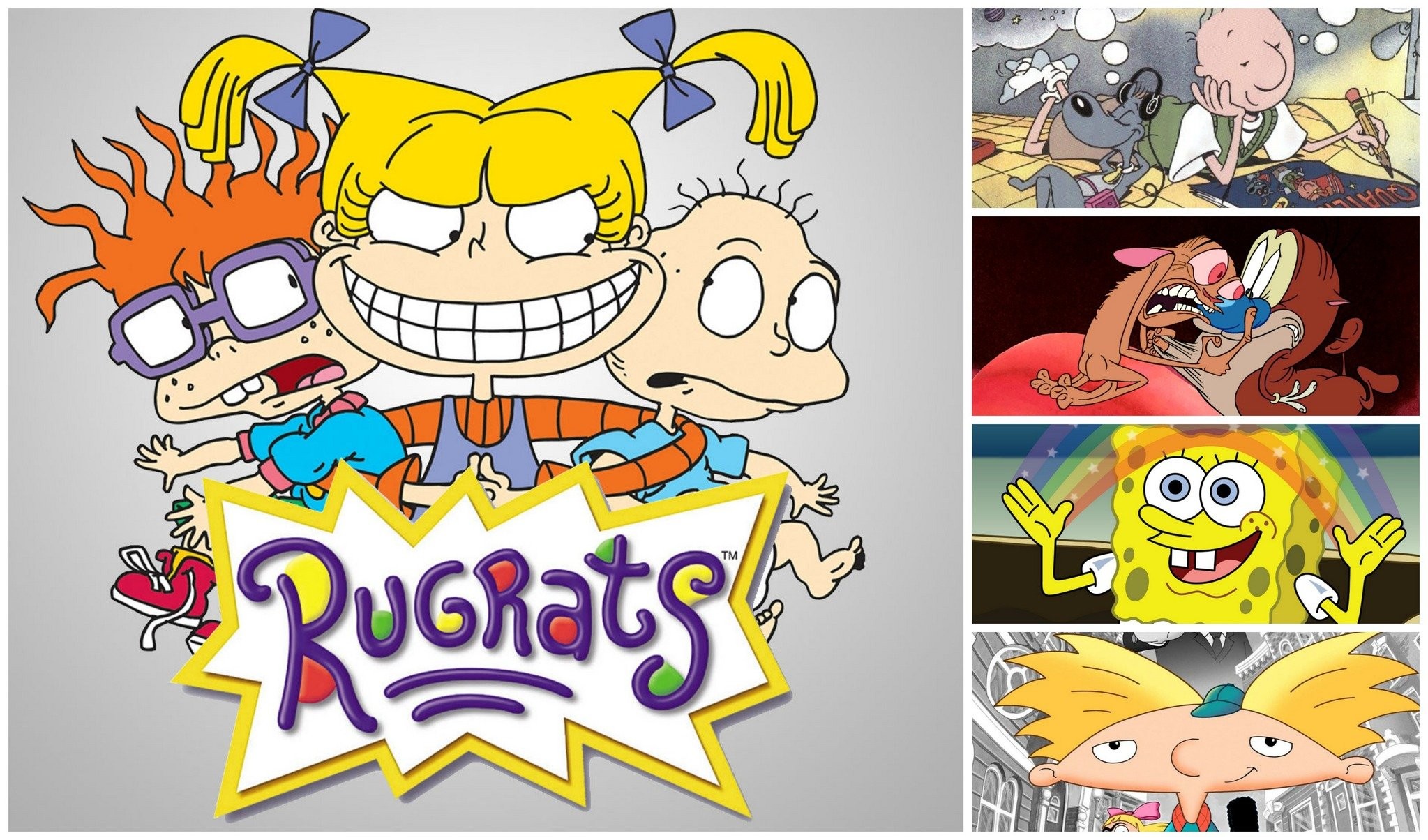For countless kids growing up in the 1990s, Nickelodeon wasn’t just a TV channel—it was a cultural phenomenon. Shows like *Rugrats*, *Doug*, and *SpongeBob SquarePants* became more than entertainment; they were companions that shaped our childhoods. The 90s was a golden era for animation, blending humor, heart, and creativity in ways that still resonate with audiences today. Whether you were dodging bullies with Arnold in *Hey Arnold!* or solving mysteries with the gang in *Aaahh!!! Real Monsters*, Nickelodeon had something for everyone. This nostalgic journey through time will take you back to those cherished moments and remind you why these cartoons remain iconic.
Nickelodeon's rise to prominence in the 90s wasn’t just about colorful characters and catchy theme songs; it was about creating a shared experience. From the infamous green slime of *Double Dare* to the quirky life lessons in *Clarissa Explains It All*, Nickelodeon understood what kids wanted: fun, relatability, and a touch of rebellion. The channel’s programming was a masterclass in storytelling, balancing slapstick comedy with meaningful messages about friendship, family, and growing up. These shows didn’t just entertain—they taught us how to navigate the complexities of childhood. For many, Nickelodeon was a safe haven, a place where imagination ran wild and anything seemed possible.
Now, decades later, the legacy of Nickelodeon cartoons from the 90s continues to thrive. Streaming platforms have made it easier than ever to revisit these beloved shows, introducing them to a new generation of fans. Whether you’re reminiscing about your own childhood or sharing these classics with your kids, there’s no denying the timeless appeal of Nickelodeon’s animated gems. So, grab your favorite snack, settle into your comfiest chair, and get ready to embark on a nostalgic journey through time as we explore the unforgettable world of Nickelodeon cartoons from the 90s.
Read also:911 Lone Star Cast A Comprehensive Guide To The Stars Of The Hit Tv Series
Table of Contents
- Why Nickelodeon Cartoons Defined a Generation
- What Made Nickelodeon’s Animation Style Unique?
- The Top 10 Nickelodeon Cartoons of the 90s
- How Did Nickelodeon Create Such Memorable Characters?
- What Role Did Nickelodeon Play in 90s Pop Culture?
- Why Do People Still Love Nickelodeon Cartoons Today?
- Nickelodeon Cartoons 90s List: A Nostalgic Journey Through Time
- Frequently Asked Questions About Nickelodeon Cartoons
Why Nickelodeon Cartoons Defined a Generation?
Nickelodeon cartoons in the 90s were more than just a form of entertainment—they were a cultural touchstone that defined an entire generation. Unlike other networks, Nickelodeon had an uncanny ability to connect with its audience on a deeply personal level. The channel’s programming was a reflection of the kids who watched it, addressing real-life issues like bullying, self-esteem, and family dynamics in ways that were both relatable and entertaining. Shows like *Doug* and *Hey Arnold!* tackled these topics with sensitivity, offering viewers not just escapism but also a mirror to their own lives.
One of the reasons Nickelodeon cartoons resonated so strongly was their emphasis on authenticity. The characters weren’t perfect; they were flawed, quirky, and often awkward—just like the kids watching them. Arnold’s struggles with his parents’ disappearance in *Hey Arnold!* or Doug’s constant anxiety about fitting in struck a chord with viewers who saw themselves in these stories. This authenticity fostered a sense of connection, making Nickelodeon a trusted companion for kids navigating the ups and downs of childhood.
Moreover, Nickelodeon’s programming was groundbreaking in its inclusivity. The channel featured diverse characters and storylines that reflected the real world. For instance, *The Wild Thornberrys* introduced viewers to cultures and wildlife from around the globe, while *Rugrats* celebrated multiculturalism through its depiction of Jewish and African-American families. By embracing diversity, Nickelodeon ensured that every child could find a piece of themselves in its shows, further solidifying its role as a defining force in 90s pop culture.
What Made Nickelodeon’s Animation Style Unique?
Nickelodeon’s animation style in the 90s was a breath of fresh air, setting it apart from other networks like Disney and Cartoon Network. While Disney focused on polished, fairy-tale-like visuals and Cartoon Network leaned into edgy, surreal humor, Nickelodeon carved out its own niche with a distinctively quirky and imperfect aesthetic. The hand-drawn animation often featured exaggerated expressions, vibrant colors, and a slightly rough-around-the-edges charm that made the shows feel more personal and relatable.
How Did Nickelodeon’s Art Style Reflect Its Themes?
The art style of Nickelodeon cartoons was a perfect match for the themes they explored. For example, the chaotic and colorful world of *CatDog* mirrored the show’s exploration of sibling rivalry and coexistence. Similarly, the exaggerated features of characters like Tommy Pickles from *Rugrats* or Helga Pataki from *Hey Arnold!* emphasized their larger-than-life personalities, making them unforgettable. This visual storytelling approach allowed Nickelodeon to convey complex emotions and ideas without relying solely on dialogue.
Why Was Imperfection So Important in Nickelodeon’s Animation?
Imperfection was key to Nickelodeon’s appeal. Unlike the sleek, almost too-perfect animations of other networks, Nickelodeon embraced a raw, handcrafted look that felt more human. This imperfection extended to the characters themselves, who were often flawed, awkward, and wonderfully real. For instance, the misshapen body of Ren and Stimpy or the intentionally crude animation of *Rocko’s Modern Life* added to the humor and charm of these shows. By rejecting perfection, Nickelodeon created a world that felt accessible and relatable, inviting viewers to embrace their own quirks and imperfections.
Read also:Exploring Brian Cox Time Travel A Fascinating Journey Through Science
The Top 10 Nickelodeon Cartoons of the 90s
No discussion about Nickelodeon cartoons would be complete without highlighting the shows that defined the decade. These top 10 cartoons not only captured the hearts of 90s kids but also left an indelible mark on animation history. Let’s take a closer look at these iconic series:
- Rugrats: This beloved show followed the adventures of a group of adventurous toddlers, led by the fearless Tommy Pickles. Its imaginative storytelling and heartfelt moments made it a household name.
- Hey Arnold!: Set in a bustling urban neighborhood, this show explored themes of friendship, family, and self-discovery through the eyes of its titular character, Arnold.
- SpongeBob SquarePants: Premiering in 1999, this underwater comedy quickly became a cultural phenomenon, thanks to its zany humor and lovable characters.
- Doug: Doug Funnie’s journal entries provided a window into the mind of a shy, introspective boy navigating the challenges of middle school.
- The Ren & Stimpy Show: Known for its surreal humor and groundbreaking animation, this show pushed the boundaries of what a kids’ cartoon could be.
- Rocko’s Modern Life: This quirky series followed an anthropomorphic wallaby as he navigated the absurdities of adult life in a satirical take on modern society.
- Aaahh!!! Real Monsters: A hilarious yet slightly spooky show about a trio of monster trainees learning how to scare humans.
- The Angry Beavers: The misadventures of two beaver brothers, Daggett and Norbert, provided endless laughs and heartwarming moments.
- CatDog: This bizarre yet endearing show featured a conjoined cat and dog navigating life in a world that didn’t always understand them.
- The Wild Thornberrys: This globe-trotting adventure series followed a young girl named Eliza who could talk to animals, blending education with entertainment.
How Did Nickelodeon Create Such Memorable Characters?
One of Nickelodeon’s greatest strengths was its ability to craft characters that felt like real people. From Tommy Pickles’ adventurous spirit to Helga Pataki’s unrequited love for Arnold, these characters were multidimensional and relatable. Nickelodeon achieved this by giving its characters distinct personalities, motivations, and flaws, ensuring they resonated with viewers on a deeper level.
What Role Did Voice Acting Play in Bringing Characters to Life?
Voice acting was a crucial element in making Nickelodeon’s characters unforgettable. Talented actors like E.G. Daily (*Rugrats*’ Tommy Pickles), Billy West (*Ren & Stimpy*), and Tom Kenny (*SpongeBob SquarePants*) brought these characters to life with their unique voices and impeccable timing. Their performances added layers of emotion and humor, making the characters feel alive and relatable.
Why Were Side Characters Just as Important as the Protagonists?
Nickelodeon understood the importance of a strong supporting cast. Characters like Angelica Pickles, Helga Pataki, and Norbert Beaver were just as beloved as the main protagonists, often stealing the spotlight with their hilarious antics and larger-than-life personalities. These side characters added depth to the stories and provided a perfect foil for the heroes, creating a rich and dynamic world.
What Role Did Nickelodeon Play in 90s Pop Culture?
Nickelodeon wasn’t just a TV channel; it was a cultural powerhouse that shaped the 90s in profound ways. From its iconic orange logo to its unforgettable theme songs, Nickelodeon became synonymous with childhood for an entire generation. The channel’s influence extended beyond the screen, inspiring merchandise, theme parks, and even slang that kids used in their everyday lives.
How Did Nickelodeon Influence Fashion and Trends?
Nickelodeon cartoons had a significant impact on 90s fashion and trends. Characters like Tommy Pickles and Arnold became style icons, with their signature outfits inspiring kids to emulate their looks. The channel also launched successful merchandise lines, from *Rugrats* lunchboxes to *SpongeBob* sneakers, cementing its place in 90s pop culture.
Why Were Nickelodeon’s Theme Songs So Memorable?
The theme songs of Nickelodeon cartoons were catchy, energetic, and instantly recognizable. Songs like *Rugrats’* “A Baby’s Gotta Do What a Baby’s Gotta Do” and *SpongeBob’s* “Who Lives in a Pineapple Under the Sea?” became earworms that are still beloved today. These theme songs set the tone for each show and became an integral part of the Nickelodeon experience.
Why Do People Still Love Nickelodeon Cartoons Today?
Decades after their original air dates, Nickelodeon cartoons from the 90s continue to captivate audiences of all ages. Their timeless appeal lies in their universal themes, relatable characters, and nostalgic charm. For millennials, these shows are a comforting reminder of simpler times, while younger viewers are drawn to their humor and creativity.
Streaming platforms like Paramount+ and Hulu have made it easier than ever to revisit these classics, introducing them to a new generation of fans. Social media has also played a role in keeping the spirit of Nickelodeon alive, with fan art, memes, and discussions keeping the conversation going. The enduring popularity of shows like *SpongeBob SquarePants* proves that Nickelodeon’s magic is truly timeless.

